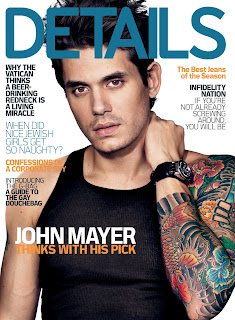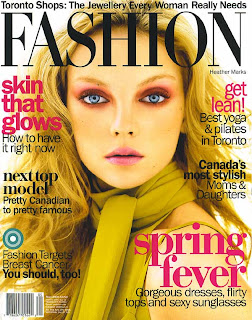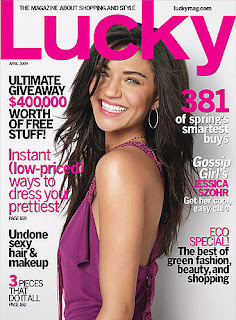My group product was based on a christmas horror, and therefore when creating the products I had to keep in mind that the concept and theme of the work I produced had to appear creepy and eery. I analysed different posters, magazines and trailers in order to be able to easily recognise how the codes and conventions of each are put into place, this made my editing process a lot easier for me.
I produced a film trailer with my group, and individually produced a film poster and a magazine cover.
The codes and conventions of a magazine cover are:
 A Masthead: A masthead is the title of the magazine which lets the readers know what exactly they are reading
A Masthead: A masthead is the title of the magazine which lets the readers know what exactly they are reading
I chose to call the magazine: EMPIRE FILM, in order to make it sound upper class and regal. I chose a suitable font which was easily readable so that it was obvious to the viewer what my magazine was called.
 Main Image: This typically consists of models, musicians or actors, therefore I shall be using an image of our main character of the film. Instead of using a serious image shot like I did for the poster, I shall be using a more light hearted image in order to show the personality of the actor, which therefore will make the magazine appear more personal and friendly. I wanted to portray that the actor was not evil in real life, and therefore chose an image of Josh smiling and dancing.
Main Image: This typically consists of models, musicians or actors, therefore I shall be using an image of our main character of the film. Instead of using a serious image shot like I did for the poster, I shall be using a more light hearted image in order to show the personality of the actor, which therefore will make the magazine appear more personal and friendly. I wanted to portray that the actor was not evil in real life, and therefore chose an image of Josh smiling and dancing.
Strapline: Seen as an introductory headline below the main title (the masthead), to give an insight to the magazine.
For my strapline I took more of an advertising take on it "EXCLUSIVE: Interview with the star of 'You Better Watch Out' I used this as i felt as though it would draw in the audience if they were a fan of the film, it also highlights the main purpose of the edition of the magazine.
For my strapline I took more of an advertising take on it "EXCLUSIVE: Interview with the star of 'You Better Watch Out' I used this as i felt as though it would draw in the audience if they were a fan of the film, it also highlights the main purpose of the edition of the magazine.
Top and Bottom Strip: These are the strips below and above the magazine that give further information to what may be included in the magazine. Mostly being the interesting parts of the magazine. I chose to only use one strip at the bottom to make sure that i had enough room for more magazine content, i placed this strip at the bottom of my magazine in order todraw attention to it. I bordered this section with a mustard yellow colour, which I sampled from the bottom of Josh's belt colour. I done this as i wanted to make sure that my magazine followed a set colour scheme and therefore it fit into my magazines look.
 Tag: This is one word or a phrase which is used in order to engage the reader and draw them in to reading your magazine for example ‘Exclusive’, ‘Sensational’, this showing that the magazine has high compliments.
Tag: This is one word or a phrase which is used in order to engage the reader and draw them in to reading your magazine for example ‘Exclusive’, ‘Sensational’, this showing that the magazine has high compliments.I used the word 'Exclusive' As it puts across the impression that that would be the only magazine featuring that particular content in it, and therefore that would be a good selling point as no other magazine would be featuring the content.
Coverlines: These are essential articles which are featured inside the magazine, they are usually shown along the left hand side of the magazine, therefore i used this placement in order to comply with the codes and conventions of the magazine. As my magazine is a film magazine I decided that my cover line would be 'The Top 10 Films of 2012' therefore this would be an up to date article which would enable readers to see what the best up and coming films are, I also used an image of 'The Hobbit' as it would make the audience interract with the article with more ease.
Barcode/Dateline & Price: A dateline in which the date of publish and the price are shown, the barcode is just the importance of the retailer. I created the barcode myself instead of getting one off of the interciew as i did not want it to match any other that could be found, i made the date line and price both small as I didnt want it to draw away the attention of the viewer, however i still made it visable as it is a vital piece of information.
 I made sure that a lot of my fonts were in different sizes in order to draw attention to the headings, which would then make the reader look at the additional information below. I also made sure that I used bright colours for the font which also fitted in with the colour scheme of the image, therefore this made my magazine not look trashy and randomly collated. By using a colour scheme it gave my magazine a smart and sophisticated look. Before starting to create my magazine cover I carried out research into the standard magazine sizes and from there decided that I would use an 8x11 inch magazine cover, this was so that I fitted the codes and conventions of magazine covers and therefore it would not look unusual or out of place. At the bottom of my magazine I used a font made out of film strips, I done this as i thought that it fitted in well with the concept of my magazine and also made it more interesting to look at, this font i found on a website called 'dafont' which was free. This meant that i did not have to spend any money creating my magazine as i was able to collacte all of the resources for free which i needed to use. All in all i think that my magazine was particularly successful, it was a fast and easy process which I had previously gained the skills required to carry this task out both quickly and efficiently as I had already made a mock of a film poster.
I made sure that a lot of my fonts were in different sizes in order to draw attention to the headings, which would then make the reader look at the additional information below. I also made sure that I used bright colours for the font which also fitted in with the colour scheme of the image, therefore this made my magazine not look trashy and randomly collated. By using a colour scheme it gave my magazine a smart and sophisticated look. Before starting to create my magazine cover I carried out research into the standard magazine sizes and from there decided that I would use an 8x11 inch magazine cover, this was so that I fitted the codes and conventions of magazine covers and therefore it would not look unusual or out of place. At the bottom of my magazine I used a font made out of film strips, I done this as i thought that it fitted in well with the concept of my magazine and also made it more interesting to look at, this font i found on a website called 'dafont' which was free. This meant that i did not have to spend any money creating my magazine as i was able to collacte all of the resources for free which i needed to use. All in all i think that my magazine was particularly successful, it was a fast and easy process which I had previously gained the skills required to carry this task out both quickly and efficiently as I had already made a mock of a film poster.
Poster Codes and Conventions

 At the top of the poster I used font in which I again found on 'DAFONT' which says"You Better Watch out" as this is the title of the film, and by using it in a larger font it would make it blatently obvious as to what the film was. I chose to use a deadpan image which i took of josh in the photography studio.
At the top of the poster I used font in which I again found on 'DAFONT' which says"You Better Watch out" as this is the title of the film, and by using it in a larger font it would make it blatently obvious as to what the film was. I chose to use a deadpan image which i took of josh in the photography studio.At the bottom of the poster I included additional information such as directors/producers etc, however as there was only 3 of us in our group I had to improvise and make up names in order to make it appear less tedious, I used a condensed text in order to fit the codes and conventions.
It was easy to distinguish the codes and conventions of horror film posters, they typically are formed with dark colours, for example; reds, blacks, dark greens and purples. As my trailer was for a christmas film I decided to go with a red and black colour scheme in order to give off an eery look. Instead of using a bright red, i experimented until i found a red that fitted into the concept which I had, which turned out to be a blood red colour, similar to most horror films. I edited my film poster on a mac, and therefore whilst editing I made it appear exactly how i liked, however when viewing it on a normal windows computer, the poster appeared different and seemed to lack professionalism.
I also used a tag line in order to emphasize the film, I got this idea from both 'Cabin In The Woods' and 'Friday the 13th' as they have tag lines on their posters which say 'If An Old Man Warns You Not To Go There... MAKE FUN OF HIM' AND 'Welcome to the Crystal Maze' Therefore i came up with a tag line for my poster which was 'You wont sleep this christmas'.
Instead of going for a portrait layout i went for a landscape as i wanted it to be able to fit on billboards as opposed to signs at a bustation, and therefore used 1500x1500 pixels for my dimension. I chose to use a daunting image of our actor to enable the thoughts of the audience to be of fear.
I made a first draft of my poster and got some audience feedback from members of my class including things they liked and things that I could change, this meant that i was able to refine my work and therefore make it look more professional.
EDITING OUR FOOTAGE
I was not confident at all when editing the image, however luckily a member of our group, Josh Farrant was able to very easily edit our footage and teach and help myself along the way. Although I found it hard to pick up, I now feel a lot more confident using the editing software.
I was filmed as a character in the footage, so therefore i did not play a massive part in the filming side of things, however i feel that i have good skills when it comes to filming as i have had previous experience with using moving image during last years project and in my own personal time.
Whilst filming my group made sure that we had a lot of cuts of the same thing so that we knew we had good footage, this made it a lot easier for us when it came to selecting our scenes as we did not have to worry that we would be lacking any parts of it as we made sure that by refilming certain scenes that we had all of the footage in which we needed.
Filming in the photography darkroom posed a problem as the lighting made it difficult to see the footage, therefore throughout filming we had to change the lighting positioning in order to make sure that our footage was visable and not hard to make out.

No comments:
Post a Comment